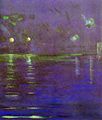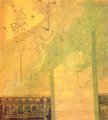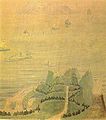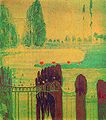193.219.57.254 (talk) No edit summary |
fixedd ate in infobox; |
||
| Line 4: | Line 4: | ||
| imagesize = 200px |
| imagesize = 200px |
||
| birthname = Mikalojus Konstantinas Čiurlionis |
| birthname = Mikalojus Konstantinas Čiurlionis |
||
| birthdate = {{birth date|1875|9| |
| birthdate = {{birth date|1875|9|22|mf=y}} |
||
| location = [[Old Varėna]] |
| location = [[Old Varėna]] |
||
| deathdate = {{death date and age|1911|4|10|1875|9| |
| deathdate = {{death date and age|1911|4|10|1875|9|22|mf=y}} |
||
| deathplace = [[Pustelnik]] |
| deathplace = [[Pustelnik]] |
||
| nationality = [[Lithuania]]n |
| nationality = [[Lithuania]]n |
||
| Line 17: | Line 17: | ||
[[Image:Juros sonata.Finale.jpg|thumb|Sonata of the Sea. ''Finale'' (1908)]] |
[[Image:Juros sonata.Finale.jpg|thumb|Sonata of the Sea. ''Finale'' (1908)]] |
||
[[Image:Pasaulio sutverimas X.jpg|thumb|''Creation of the World X'' (1906-1907)]] |
[[Image:Pasaulio sutverimas X.jpg|thumb|''Creation of the World X'' (1906-1907)]] |
||
'''Mikalojus Konstantinas Čiurlionis''' ({{OldStyleDate|September 22|1875|September 10}} in [[Old Varėna]]—{{OldStyleDate|April 10|1911|March 28}} in [[Pustelnik]] near [[Warsaw]]) was a [[Lithuania]]n [[painter]] and [[composer]] and perhaps the most famous Lithuanian artist of all time. Čiurlionis contributed to [[Symbolism (arts)|symbolism]] and [[art nouveau]] and was representative of the [[fin de |
'''Mikalojus Konstantinas Čiurlionis''' ({{OldStyleDate|September 22|1875|September 10}} in [[Old Varėna]]—{{OldStyleDate|April 10|1911|March 28}} in [[Pustelnik]] near [[Warsaw]]) was a [[Lithuania]]n [[painter]] and [[composer]] and perhaps the most famous Lithuanian artist of all time. Čiurlionis contributed to [[Symbolism (arts)|symbolism]] and [[art nouveau]] and was representative of the [[fin de siècle]] epoch. During his short life he composed about 250 pieces of music and created about 300 paintings. The majority of his paintings are housed in the M. K. Čiurlionis National Museum of Art, in [[Kaunas]], [[Lithuania]]. His works have had a profound influence on modern Lithuanian culture. The asteroid [[2420 Čiurlionis]] is named after him. |
||
==Biography== |
==Biography== |
||
Revision as of 01:30, 12 July 2008
Mikalojus Konstantinas Čiurlionis | |
|---|---|
| File:Ciurlionis.jpg | |
| Born | Mikalojus Konstantinas Čiurlionis |
| Nationality | Lithuanian |
| Education | Warsaw Conservatory, Leipzig Conservatory, Warsaw School of Fine Arts |
| Known for | Painting, musical composition |
| Notable work | Spring Sonata, In the Forest |
| Movement | Symbolism; Art nouveau |



Mikalojus Konstantinas Čiurlionis (September 22 [O.S. September 10] 1875 in Old Varėna—April 10 [O.S. March 28] 1911 in Pustelnik near Warsaw) was a Lithuanian painter and composer and perhaps the most famous Lithuanian artist of all time. Čiurlionis contributed to symbolism and art nouveau and was representative of the fin de siècle epoch. During his short life he composed about 250 pieces of music and created about 300 paintings. The majority of his paintings are housed in the M. K. Čiurlionis National Museum of Art, in Kaunas, Lithuania. His works have had a profound influence on modern Lithuanian culture. The asteroid 2420 Čiurlionis is named after him.
Biography
Čiurlionis was the oldest of nine children of his father, Constantine, and his mother, Adele. In 1878 his family moved to Druskininkai, where his father became the town organist. Čiurlionis was a musical prodigy: he could play by ear at age three and could sightread music freely by age seven. Three years out of primary school, he went to study at the musical school of Prince Michał Oginski where he learned to play several orchestral instruments, in particular the flute, from 1889 to 1893. Čiurlionis studied piano and composition at the Warsaw Conservatory from 1894 to 1899. For his graduation, in 1899, he wrote a cantata for mixed chorus and symphonic orchestra titled "De Profundis," with the guidance of the composer Symgund Noskowsky. Later he attended composition lectures at the Leipzig Conservatory (1901 to 1902), and studied drawing at the Warsaw School of Fine Arts from 1904 to 1906.
He was one of the initiators of, and a participant in, the First Exhibition of Lithuanian Art that took place in 1907 in Vileišis Palace, Vilnius. Soon after this event the Lithuanian Union of Arts was founded, and Čiurlionis was of its nineteen founding members. In 1911 at the age of 35 Čiurlionis died of pneumonia in Pustelnik sanatorium. He was buried in Vilnius' Rasos Cemetery.
Čiurlionis felt that he was a synesthete; that is, he perceived colors and music simultaneously. Many of his paintings bear the names of musical pieces: sonatas, fugues, and preludes.
Posthumous recognition
In 1911 the first posthumous exhibition of Mikalojus Konstantinas Čiurlionis' art was held in Vilnius and Kaunas. During the same year an exhibition of his art was held in Moscow, and in 1912 his works were exhibited in St. Petersburg. The National M. K. Čiurlionis School of Art was founded in Vilnius in 1945; soon afterwards the Lithuanian community in Chicago opened The Čiurlionis Art Gallery, hosting collections of his works. In 1963 the Čiurlionis Memorial Museum was opened in Druskininkai, in the house where Čiurlionis and his family lived. This museum holds biographical documents as well as photographs and reproductions of the artist's works.
Mikalojus Konstantinas Čiurlionis inspired the Lithuanian composer Osvaldas Balakauskas' work Sonata of the Mountains (1975), and every several years junior musical performers from Lithuania and neighbouring countries take part in The Čiurlionis Competition. Čiurlionis' name has been given to cliffs in Franz Josef Land, a peak in the Pamir Mountains, and to asteroid #2420, discovered by the Crimean astrophysicist Nikolaj Cernych.
Čiurlionis' works have been displayed at international exhibitions in Japan, Germany, Spain, and elsewhere. His paintings were featured at "Visual Music" fest, an homage to synesthesia that included the works of Wassily Kandinsky, James McNeill Whistler, and Paul Klee, at the Museum of Contemporary Art, Los Angeles in 2005. [1]
Musical works
Some of his most-performed musical works include:
- Prelude in F Sharp major
- String Quartet in C minor
- Prelude in A major
- Karalaitės kelionė: Pasaka (The Princess' Journey, A Fairy Tale)
- Seven fugues for organ / String Quartet in C minor
- Folk songs for choir
- Miške (In the Forest), a symphonic poem for orchestra (posthumous)
- Jūra (The Sea), a symphonic poem for orchestra (posthumous)
Paintings
The most famous Mikalojus Konstantinas Čiurlionis paintings include:
- Cycle Winter (1906-1907)
- Cycle The Zodiac (1907)
- Sonatas (1907-1908)
- Cycle Fairy-Tale (1909)
Creation of the World
-
I
-
II
-
III
-
IV
-
V
-
VI
-
VII
-
VIII
-
IX
-
X
-
XI
-
XII
-
XIII
Sonata of the Spring (1907)
-
Allegro
-
Andante
-
Scherzo
-
Finale
Sonata of the Summer (1908)
-
Allegro
-
Andante
-
Scherzo
-
Finale
Sonata of the Sun (1907)
-
Allegro
-
Andante
-
Scherzo
-
Finale
Sonata of the Sea (1908)
-
Allegro
-
Andante
-
Finale
Sonata of the Pyramids (1908)
-
Allegro
-
Scherzo
Sonata of the Stars (1908)
-
Allegro
-
Andante
Sonata of the Serpent (1908)
Diptych "Prelude and Fugue" (1908)
Triptych "Fantasy" (1908)
Other Preludes and Fugues
-
Angel. Prelude
Winter - Cycle of Eight Pictures (1906-7)
-
IV
Spring - Four Pictures (1907-8)
Summer - Cycle of Three Pictures (1907-8)
Gallery
-
Cloud Boat
-
The Past
-
Crosses in Žemaitija
-
Kings' Fairy Tale (1908-1909)
-
Tranquility (1904-1905)Tranquility (1904-1905)
-
Preludes and Fugues. Angel. Prelude





































